Salt Accumulation during Cropping Season in an Arid Irrigation Area with Shallow Water Table Depth: A 10-Year Regional Monitoring
Abstract
:1. Introduction
2. Materials and Methods
2.1. Study Area
2.2. Data Availability
2.2.1. Water Table Depth and Soil Properties
2.2.2. Field Irrigation, Precipitation and Potential Crop Evapotranspiration
2.3. Data Analysis
2.3.1. Salt Accumulation and Water Table Depth
2.3.2. Spatial Distribution of the Water Table Depth
2.3.3. Factors Influencing Salt Accumulation
3. Results
3.1. Cropping Season Climatic Factors and Field Irrigation
3.2. Cropping Season Water Table Depth
3.3. Cropping Season Salt Accumulation Pattern
3.4. Cropping Season Salt Accumulation Attribute Factors and Their Contributions
4. Discussion
Author Contributions
Funding
Data Availability Statement
Acknowledgments
Conflicts of Interest
References
- Syed, A.; Sarwar, G.; Shah, S.H.; Muhammad, S. Soil salinity research in 21(st) Century in Pakistan: Its impact on availability of plant nutrients, growth and yield of crops. Commun. Soil Sci. Plant Anal. 2021, 52, 183–200. [Google Scholar] [CrossRef]
- Shrivastava, P.; Kumar, R. Soil salinity: A serious environmental issue and plant growth promoting bacteria as one of the tools for its alleviation. Saudi J. Biol. Sci. 2015, 22, 123–131. [Google Scholar] [CrossRef] [Green Version]
- Singh, A. Soil salinization and waterlogging: A threat to environment and agricultural sustainability. Ecol. Indic. 2015, 57, 128–130. [Google Scholar] [CrossRef]
- Thenkabail, P.S. Global Croplands and their Importance for Water and Food Security in the Twenty-first Century: Towards an Ever Green Revolution that Combines a Second Green Revolution with a Blue Revolution. Remote Sens. 2010, 2, 2305–2312. [Google Scholar] [CrossRef] [Green Version]
- Jamil, A.; Riaz, S.; Ashraf, M.; Foolad, M. Gene expression profiling of plants under salt stress. Crit. Rev. Plant Sci. 2011, 30, 435–458. [Google Scholar] [CrossRef]
- Nachshon, U. Cropland soil salinization and associated hydrology: Trends, processes and examples. Water 2018, 10, 1030. [Google Scholar]
- Castaneda, C.; Herrero, J.; Latorre, B. The vanishing legacy of soil salinity data from irrigated districts: A case study from Spain and a call for action. Adv. Agron. 2020, 161, 325–355. [Google Scholar]
- Isidoro, D.; Aragues, R. River water quality and irrigated agriculture in the Ebro basin: An overview. Int. J. Water Resour. Dev. 2007, 23, 91–106. [Google Scholar] [CrossRef]
- Hart, B.; Walker, G.; Katupitiya, A.; Doolan, J. Salinity Management in the Murray–Darling Basin, Australia. Water 2020, 12, 1829. [Google Scholar] [CrossRef]
- Qureshi, A.S.; Perry, C. Managing water and salt for sustainable agriculture in the Indus Basin of Pakistan. Sustainability 2021, 13, 5303. [Google Scholar] [CrossRef]
- Qureshi, A.S.; McCornick, P.G.; Qadir, M.; Aslam, Z. Managing salinity and waterlogging in the Indus Basin of Pakistan. Agric. Water Manag. 2008, 95, 1–10. [Google Scholar] [CrossRef]
- Wang, X.; Wei, Y.; Yang, J. Analysis on water cycling in GSPAC system of Hetao Irrigation District, in InnerMongolia, China. J. Irrig. Drain. Eng. 2004, 23, 30–33. [Google Scholar]
- Xu, X.; Huang, G.; Qu, Z.; Pereira, L.S. Assessing the groundwater dynamics and impacts of water saving in the Hetao Irrigation District, Yellow River basin. Agric. Water Manag. 2010, 98, 301–313. [Google Scholar] [CrossRef]
- Chang, X. Study on Dynamic Simulation of Water and Salt and Sustainablity Strategy in Hetao Irrigation District; China Institute of Water Resources and Hydropower Research: Beijing, China, 2019. [Google Scholar]
- Chen, J.S.; Wang, F.Y.; Meybeck, M.; He, D.W.; Xia, X.H.; Zhang, L.T. Spatial and temporal analysis of water chemistry records (1958-2000) in the Huanghe (Yellow River) basin. Glob. Biogeochem. Cycles 2005, 19, GB3016. [Google Scholar] [CrossRef]
- Ren, D.Y.; Xu, X.; Hao, Y.Y.; Huang, G.H. Modeling and assessing field irrigation water use in a canal system of Hetao, upper Yellow River basin: Application to maize, sunflower and watermelon. J. Hydrol. 2016, 532, 122–139. [Google Scholar] [CrossRef]
- Wu, J.W.; Vincent, B.; Yang, J.Z.; Bouarfa, S.; Vidal, A. Remote sensing monitoring of changes in soil salinity: A case study in Inner Mongolia, China. Sensors 2008, 8, 7035–7049. [Google Scholar] [CrossRef] [Green Version]
- Morway, E.D.; Gates, T.K.; Niswonger, R.G. Appraising options to reduce shallow groundwater tables and enhance flow conditions over regional scales in an irrigated alluvial aquifer system. J. Hydrol. 2013, 495, 216–237. [Google Scholar] [CrossRef]
- Sun, W. The Analysis of Diflferent Scales Diversity Law of Irrigation Water Efficiency and Water Saving Potential in Hetao Irrigation District of Inner Mongolia; Inner Mongolia Agricultural University: Huhhot, China, 2014. [Google Scholar]
- Gao, X.; Huo, Z.; Bai, Y.; Feng, S.; Huang, G.; Shi, H.; Qu, Z. Soil salt and groundwater change in flood irrigation field and uncultivated land: A case study based on 4-year field observations. Environ. Earth Sci. 2014, 73, 2127–2139. [Google Scholar] [CrossRef]
- Liu, Z.; Chen, H.; Huo, Z.; Wang, F.; Shock, C.C. Analysis of the contribution of groundwater to evapotranspiration in an arid irrigation district with shallow water table. Agric. Water Manag. 2016, 171, 131–141. [Google Scholar] [CrossRef]
- Miao, Q.; Rosa, R.D.; Shi, H.; Paredes, P.; Zhu, L.; Dai, J.; Gonçalves, J.M.; Pereira, L.S. Modeling water use, transpiration and soil evaporation of spring wheat–maize and spring wheat–sunflower relay intercropping using the dual crop coefficient approach. Agric. Water Manag. 2016, 165, 211–229. [Google Scholar] [CrossRef]
- Xue, J. Modeling Agriculture Water Productivity at Muti-Scales Based on Water and Salt Processes in Arid Area with Shallow Groundwater; China Agricultural University: Beijing, China, 2018. [Google Scholar]
- Xue, J.; Huo, Z.; Wang, S.; Wang, C.; White, I.; Kisekka, I.; Sheng, Z.; Huang, G.; Xu, X. A novel regional irrigation water productivity model coupling irrigation- and drainage-driven soil hydrology and salinity dynamics and shallow groundwater movement in arid regions in China. Hydrol. Earth Syst. Sci. 2020, 24, 2399–2418. [Google Scholar] [CrossRef]
- Zhou, L. Influences of deficit irrigation on soil water content distribution and spring wheat growth in Hetao Irrigation District, Inner Mongolia of China. Water Supply 2020, 20, 3722–3729. [Google Scholar] [CrossRef]
- Metternicht, G.I.; Zinck, J.A. Remote sensing of soil salinity: Potentials and constraints. Remote Sens. Environ. 2003, 85, 1–20. [Google Scholar] [CrossRef]
- Wichelns, D.; Qadir, M. Achieving sustainable irrigation requires effective management of salts, soil salinity, and shallow groundwater. Agric. Water Manag. 2015, 157, 31–38. [Google Scholar] [CrossRef]
- Zeng, W.; Xu, C.; Wu, J.; Huang, J. Soil salt leaching under different irrigation regimes: HYDRUS-1D modelling and analysis. J. Arid Land 2013, 6, 44–58. [Google Scholar] [CrossRef] [Green Version]
- Fowler, D.N.; King, S.L.; Weindorf, D.C. Evaluating abiotic influences on soil salinity of inland managed wetlands and agricultural croplands in a semi-arid environment. Wetlands 2014, 34, 1229–1239. [Google Scholar] [CrossRef]
- van Rensburg, L.D.; Strydom, M.G.; du Preez, C.C.; Bennie, A.T.P.; le Roux, P.A.L.; Pretorius, J.P. Prediction of salt balances in irrigated soils along the lower Vaal River, South Africa. Water 2008, 34, 11–17. [Google Scholar] [CrossRef] [Green Version]
- Ragab, R.A.; Amer, F. Estimating water table contribution to the water supply of maize. Agric. Water Manag. 1986, 11, 221–230. [Google Scholar] [CrossRef]
- Kahlown, M.A.; Ashraf, M.; Zia ul, H. Effect of shallow groundwater table on crop water requirements and crop yields. Agric. Water Manag. 2005, 76, 24–35. [Google Scholar] [CrossRef]
- Jin, X.M.; Vekerdy, Z.; Zhang, Y.K.; Liu, J.T. Soil salt content and its relationship with crops and groundwater depth in the Yinchuan Plain (China) using remote sensing. Arid Land Res. Manag. 2012, 26, 227–235. [Google Scholar] [CrossRef]
- Zarai, B.; Walter, C.; Michot, D.; Montoroi, J.P.; Hachicha, M. Soil salinization monitoring method evolution at various spatial and temporal scales in arid context: A review. Arab. J. Geosci. 2021, 14, 283. [Google Scholar]
- Zhang, X.; Guo, P.; Zhang, F.; Liu, X.; Yue, Q.; Wang, Y. Optimal irrigation water allocation in Hetao Irrigation District considering decision makers’ preference under uncertainties. Agric. Water Manag. 2021, 246, 106670. [Google Scholar] [CrossRef]
- Wu, J.; Zhao, L.; Huang, J.; Yang, J.; Vincent, B.; Bouarfa, S.; Vidal, A. On the effectiveness of dry drainage in soil salinity control. Sci. China Ser. E Technol. Sci. 2009, 52, 3328–3334. [Google Scholar] [CrossRef]
- Wang, X.H.; Wang, C.Z.; Wang, X.W.; Huo, Z.L. Response of soil compaction to the seasonal freezing-thawing process and the key controlling factors. Catena 2020, 184, 104247. [Google Scholar] [CrossRef]
- Allen, R.G.; Pereira, L.S.; Raes, D.; Smith, M. FAO Irrigation and Drainage Paper No. 56; Food and Agriculture Organization of the United Nations: Rome, Italy, 1998; Volume 56, p. e156. [Google Scholar]
- Philip, G.M.; Watson, D.F. A precise method for determining contoured surfaces. APPEA J. 1982, 22, 205–212. [Google Scholar] [CrossRef]
- Watson, D.F.; Philip, G.M. A refinement of inverse distance weighted interpolation. Geo-Processing 1985, 2, 315–327. [Google Scholar]
- Bartier, P.M.; Keller, C.P. Multivariate interpolation to incorporate thematic surface data using inverse distance weighting (IDW). Comput. Geosci. 1996, 22, 795–799. [Google Scholar] [CrossRef]
- Lu, G.Y.; Wong, D.W. An adaptive inverse-distance weighting spatial interpolation technique. Comput. Geosci. 2008, 34, 1044–1055. [Google Scholar] [CrossRef]
- Deng, J.-L. Control problems of grey systems. Syst. Control Lett. 1982, 1, 288–294. [Google Scholar]
- Kuo, Y.; Yang, T.; Huang, G.W. The use of grey relational analysis in solving multiple attribute decision-making problems. Comput. Ind. Eng. 2008, 55, 80–93. [Google Scholar] [CrossRef]
- DPIRD. Measuring Soil Salinity. 4 May 2021. Available online: https://www.agric.wa.gov.au/soil-salinity/measuring-soil-salinity (accessed on 17 August 2021).
- Shokri, N.; Lehmann, P.; Or, D. Evaporation from layered porous media. J. Geophys. Res. Solid Earth 2010, 115, B06204. [Google Scholar] [CrossRef] [Green Version]

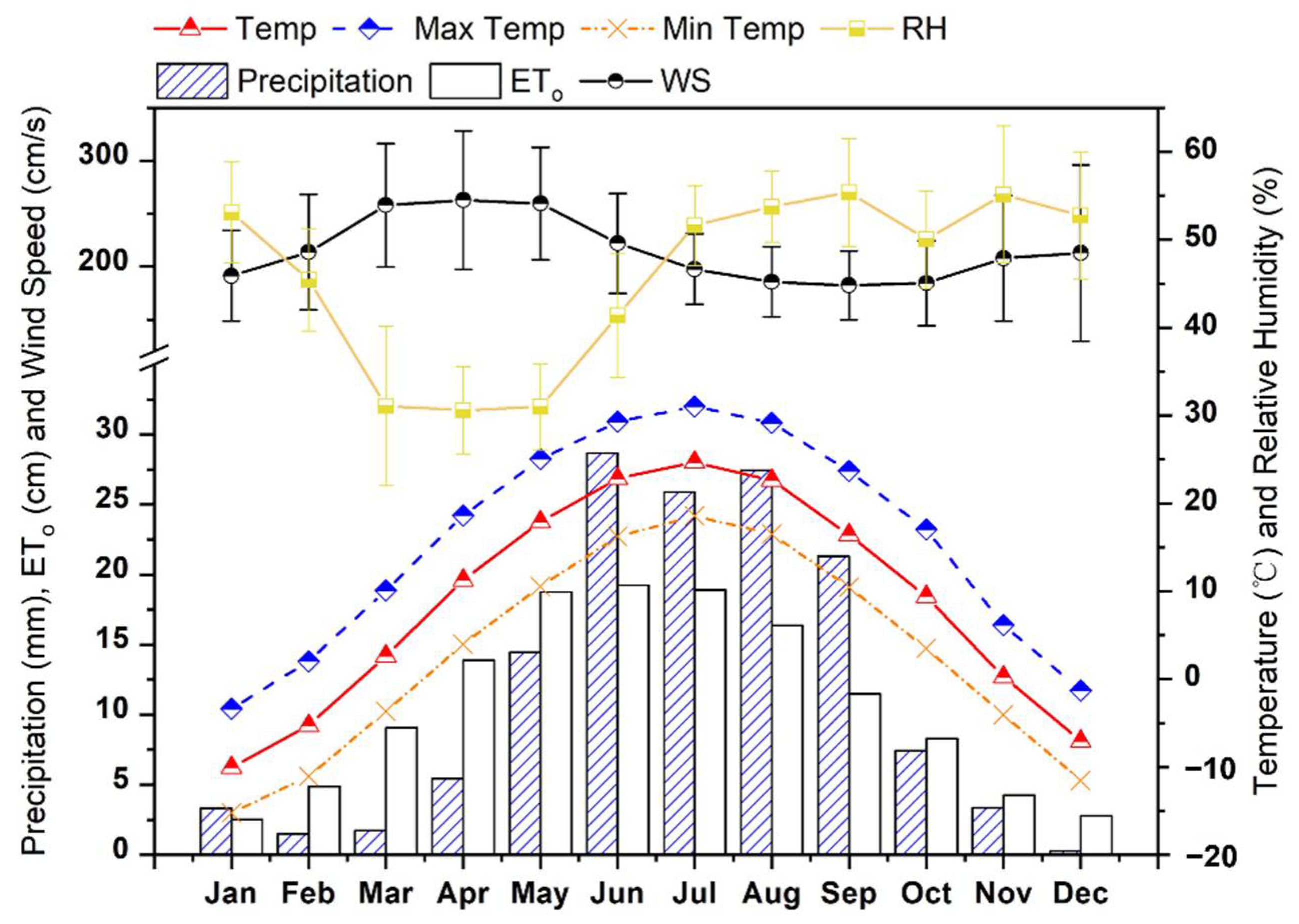
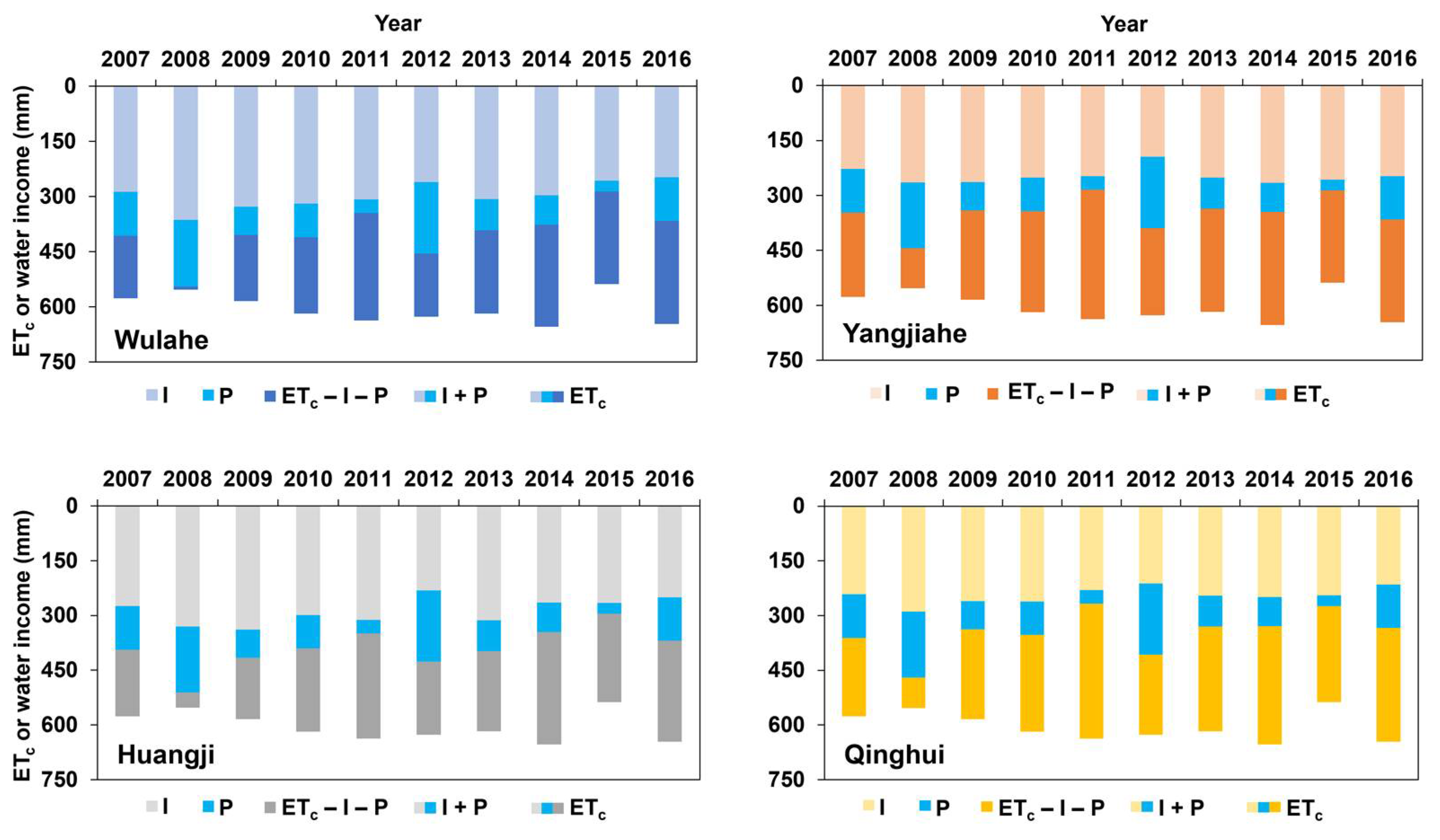
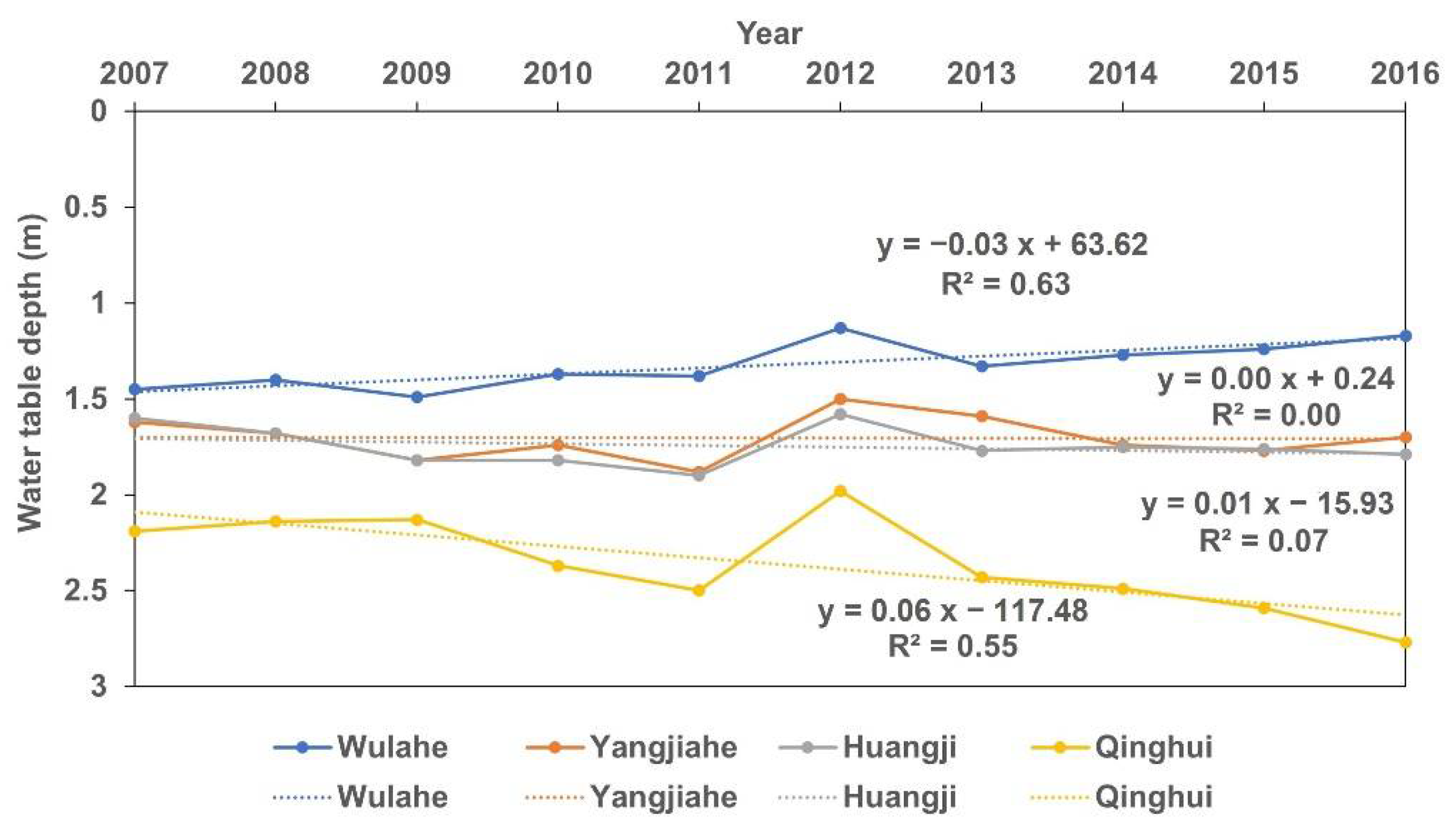
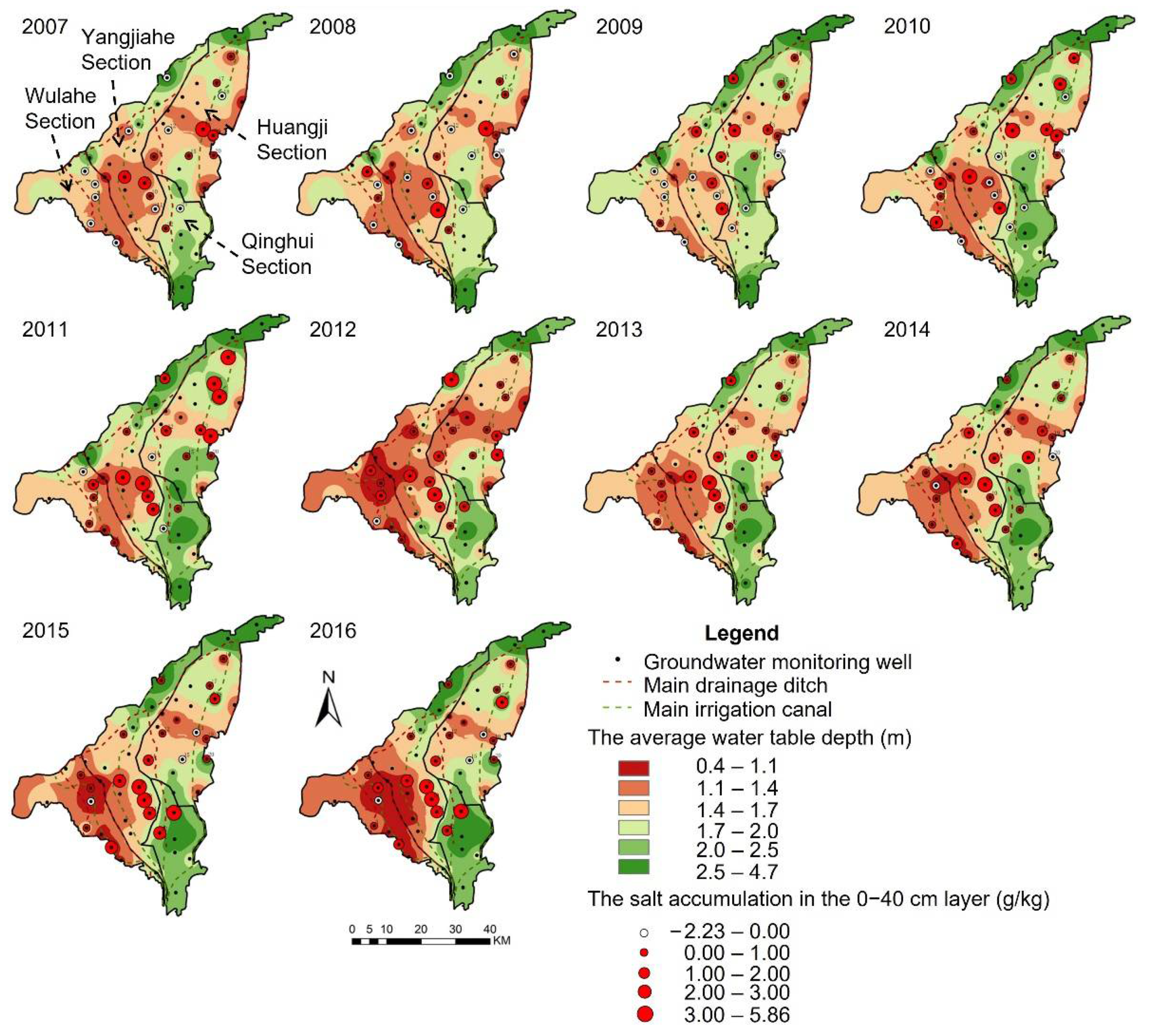
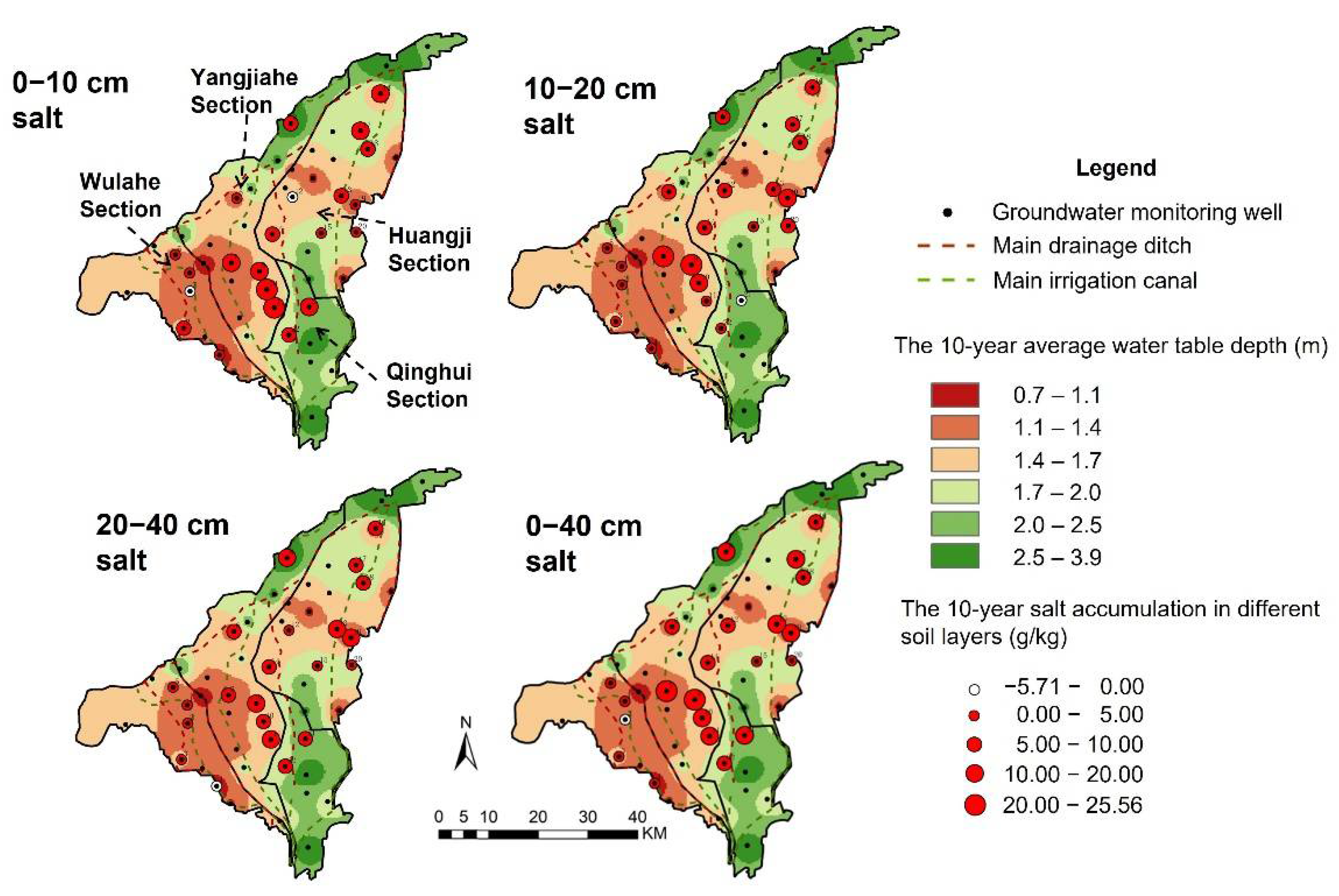

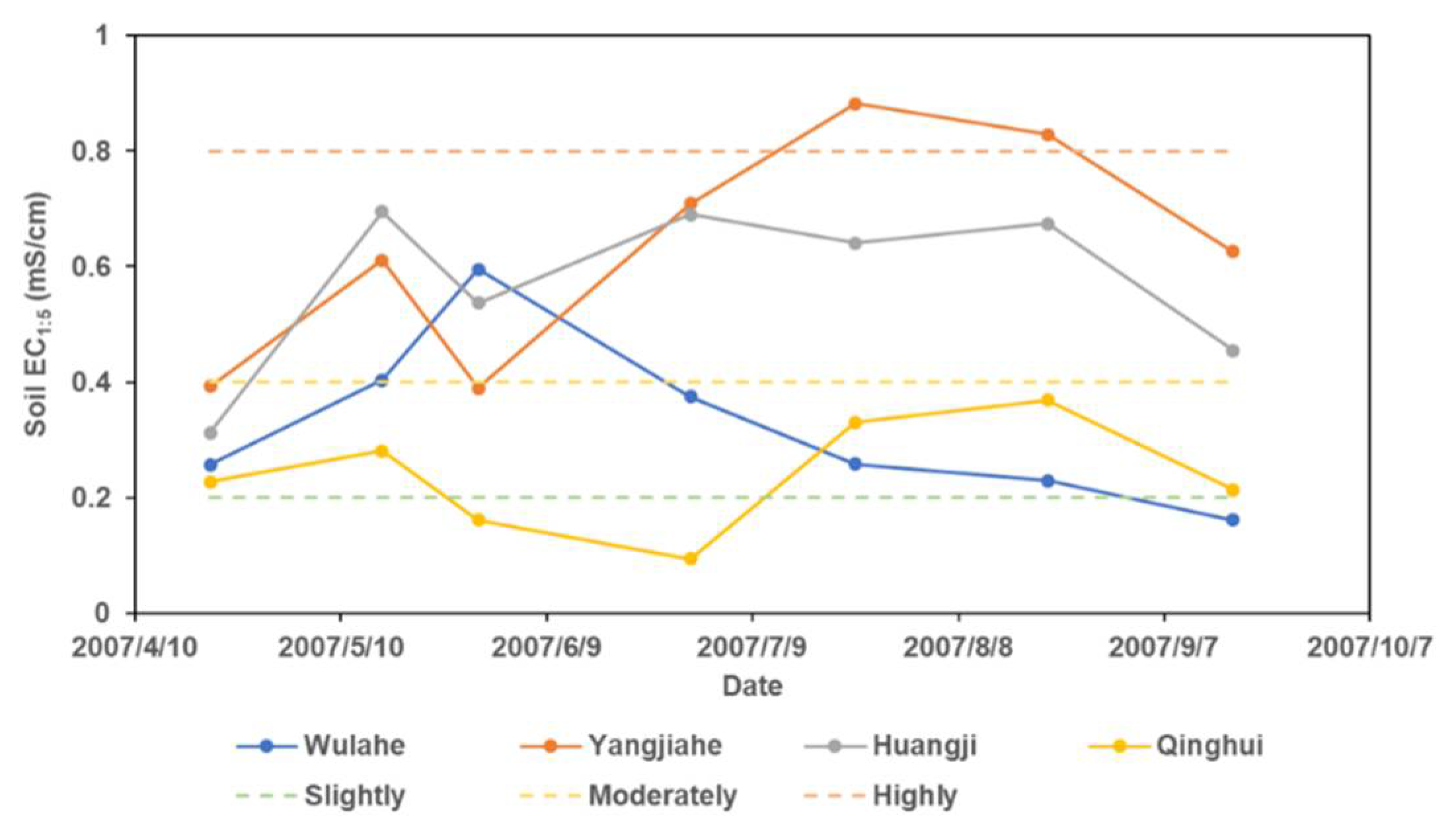

| No. | Depth (cm) | Soil Texture | ρ (g/cm3) | No. | Depth (cm) | Soil Texture | ρ (g/cm3) |
|---|---|---|---|---|---|---|---|
| 1 | 0–10 | loam | 1.53 | 12 | 0–10 | loam | 1.48 |
| 10–20 | sandy loam | 1.60 | 10–20 | loam | 1.52 | ||
| 20–40 | sandy loam | 1.46 | 20–40 | loam | 1.39 | ||
| 2 | 0–10 | loam | 1.50 | 13 | 0–10 | clay loam | 1.53 |
| 10–20 | loam | 1.48 | 10–20 | loam | 1.66 | ||
| 20–40 | loam | 1.50 | 20–40 | silty loam | 1.56 | ||
| 3 | 0–10 | silty loam | 1.32 | 14 | 0–10 | loam | 1.47 |
| 10–20 | loam | 1.45 | 10–20 | clay loam | 1.39 | ||
| 20–40 | loam | 1.34 | 20–40 | loam | 1.49 | ||
| 4 | 0–10 | loam | 1.52 | 15 | 0–10 | loam | 1.47 |
| 10–20 | loam | 1.51 | 10–20 | silty clay loam | 1.74 | ||
| 20–40 | loam | 1.43 | 20–40 | loam | 1.63 | ||
| 5 | 0–10 | loam | 1.40 | 16 | 0–10 | clay loam | 1.33 |
| 10–20 | loam | 1.51 | 10–20 | clay loam | 1.37 | ||
| 20–40 | clay loam | 1.52 | 20–40 | clay loam | 1.41 | ||
| 6 | 0–10 | sandy loam | 1.49 | 17 | 0–10 | sandy loam | 1.25 |
| 10–20 | sandy loam | 1.57 | 10–20 | clay loam | 1.32 | ||
| 20–40 | sandy loam | 1.46 | 20–40 | sandy loam | 1.40 | ||
| 7 | 0–10 | loam | 1.29 | 18 | 0–10 | silty loam | 1.59 |
| 10–20 | loam | 1.51 | 10–20 | silty clay loam | 1.63 | ||
| 20–40 | sandy loam | 1.39 | 20–40 | loam | 1.34 | ||
| 8 | 0–10 | loam | 1.29 | 19 | 0–10 | loam | 1.45 |
| 10–20 | loam | 1.34 | 10–20 | sand | 1.44 | ||
| 20–40 | loam | 1.30 | 20–40 | sand | 1.38 | ||
| 9 | 0–10 | loam | 1.44 | 20 | 0–10 | loam | 1.57 |
| 10–20 | loam | 1.66 | 10–20 | loam | 1.70 | ||
| 20–40 | loam | 1.65 | 20–40 | loam | 1.50 | ||
| 10 | 0–10 | loam | 1.40 | 21 | 0–10 | clay loam | 1.69 |
| 10–20 | loam | 1.41 | 10–20 | clay loam | 1.45 | ||
| 20–40 | loam | 1.38 | 20–40 | clay loam | 1.40 | ||
| 11 | 0–10 | sandy loam | 1.36 | 22 | 0–10 | clay loam | 1.20 |
| 10–20 | sandy loam | 1.38 | 10–20 | clay loam | 1.25 | ||
| 20–40 | sandy loam | 1.43 | 20–40 | clay loam | 1.40 |
Publisher’s Note: MDPI stays neutral with regard to jurisdictional claims in published maps and institutional affiliations. |
© 2022 by the authors. Licensee MDPI, Basel, Switzerland. This article is an open access article distributed under the terms and conditions of the Creative Commons Attribution (CC BY) license (https://creativecommons.org/licenses/by/4.0/).
Share and Cite
Wang, C.; Luo, Y.; Huo, Z.; Liu, Z.; Liu, G.; Wang, S.; Lin, Y.; Wu, P. Salt Accumulation during Cropping Season in an Arid Irrigation Area with Shallow Water Table Depth: A 10-Year Regional Monitoring. Water 2022, 14, 1664. https://doi.org/10.3390/w14101664
Wang C, Luo Y, Huo Z, Liu Z, Liu G, Wang S, Lin Y, Wu P. Salt Accumulation during Cropping Season in an Arid Irrigation Area with Shallow Water Table Depth: A 10-Year Regional Monitoring. Water. 2022; 14(10):1664. https://doi.org/10.3390/w14101664
Chicago/Turabian StyleWang, Chaozi, Yuanyuan Luo, Zailin Huo, Zhongyi Liu, Geng Liu, Shuai Wang, Yifan Lin, and Peijin Wu. 2022. "Salt Accumulation during Cropping Season in an Arid Irrigation Area with Shallow Water Table Depth: A 10-Year Regional Monitoring" Water 14, no. 10: 1664. https://doi.org/10.3390/w14101664







